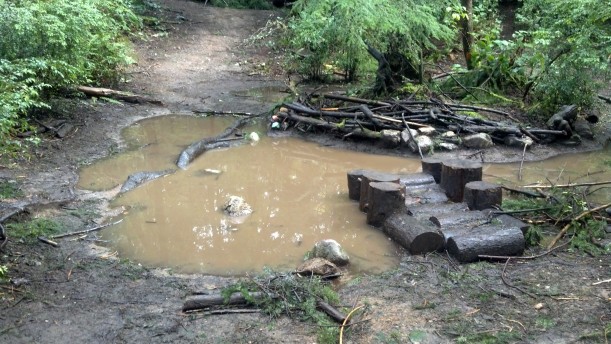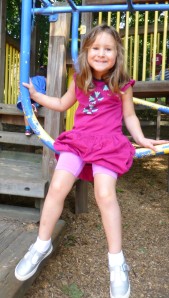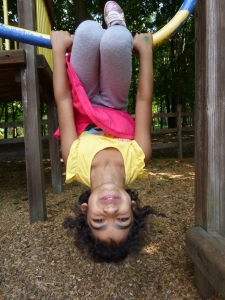“To a child, the world is filled with endless possibilities. They learn through art what will work and what won’t. Because there is not one right answer, art presents an opportunity to be creative problem solvers or “risk takers” and meet challenges in new ways. A majority of young children will most likely NOT grow up to be the next Picasso but being exposed to appropriate art experiences from the earliest years promotes divergent thinking skills — valuable for future scientists, mathematicians and engineers. ”
Questions Regarding Emergent Curriculum
This week, I presented Growing Their Curriculum: The Emergent, Interest-Driven Curriculum (How It’s Done in a Real Classroom) at the Young Child Expo and Conference. We had a lively discussion near the end and we missed a few of the questions posted by attendees. Below are some of the questions.
How do you incorporate an emergent curriculum when using a prescribed curriculum?
One of the ways to work within this predefined structure is to set aside short sections of your day to study the children’s interests. Although it is lovely to devote your entire day to child-led research, it is not always possible. If 15 minutes a day or two periods per week are all you can manage with a hectic schedule, it will still be more than never acknowledging your students’ desires to delve further into their own questions.
How to explain an emergent curriculum to parents?
Parents want their children to grow and succeed. They need to know that their child will do so in your classroom. When explaining the use of an emergent curriculum to teachers, I adamantly suggest the requirement of fully knowing your students learning goals be they benchmarks, standards or developmental milestones. When you know what your children need to learn next, you will know how to support them as they grow. Once you are comfortable with this knowledge, explaining to parents how you will sheppard their child along the process is more manageable. Be ready to explain how their child will practice, experiment and grow in all domains.
The most powerful evidence of the learning possible in an emergent curriculum comes from the children’s own work and voices. Share these with parents and include explanations of the learning happening. Use documentation boards, blogs, tweets, letters home or any other communication method that works for you to present the parents with examples of their child’s growth.
Is it still Reggio? Do you consider yourself “Reggio-Inspired?”
My teaching is Reggio Emilia inspired. Although a class cannot become “Reggio”, many of the truths at the heart of the Reggio Emilia Schools can be applied within our classrooms. I believe that each child comes to my class full of curiosity and as a capable, experienced scientist. My job is to help them explore their interests while providing them with the environment and tools they need to grow in all domains. An Every Day Story gives a wonderful description of Reggio-inspired teaching.
How do you create art projects based on a family or gardening unit?
First, let me say that there are practically no “craft” projects completed in our classroom. When we are researching a topic, we often draw, sculpt, paint and invent representations that go along with our studies. Many times, the creation of a finished product is not nearly as important as the process that goes along with it. The children’s work is can be seen through photos, their journals, portfolios and their drawings lovingly taped to anything that is not painted. (We wouldn’t want to damage the walls, so we tape onto everything else.) I let go of “art projects” when I realized that a beautiful finished product was not the point of using materials. In our room the following are important:
- experimentation with materials
- explorations of a material’s properties
- discovering limits and boundaries to our plans (gravity, space, time, other friends in our class)
- investigating options when met by these limits
- adjusting and moving forward
In a family study, we have drawn and painted our families. We have sculpted our mothers and built our homes out of boxes.
A garden study might make us curious about how to create a vegetable garden using water colors. Maybe we’d even make masking-tape vegetables. There is no denying the joy of unhindered access to masking-tape.
What is the longest time you have worked on a unit?
Just to get this off my chest, I don’t actually refer to our studies as units. I’m not actually sure why. I think a unit reminds me of a set in stone group of activities that were devised by the teacher to meet the teacher’s goals. A unit also sounds like a measurement, something with a definite beginning and ending.
I usually refer to our learning as studying topics or conducting research. Many years ago, I had the pleasure of studying with Erin Kenny of Cedarsong Nature School. Erin referred to her take on emergent curriculum as “flow learning.” Erin’s program wa completely outdoors and naturally (pun intended) connected to the daily ebb and flow of questions offered by the environment. It makes sense that a topic of study might last for weeks or minutes. I’ve brought a bit of this flexibility to our classroom.
A topic might be investigated for weeks at a time. This year, I’m fairly certain we could have continued studying pandas until the children grew beards. Even though we sensed a shift in their interest and have since moved on, pandas still play a huge role in the children’s play each day.
At other times, an engaging topic springs up so quickly that you daren’t miss the opportunity to learn more. Our very short (one Morning Meeting) molecule study is a great example.
Then, there are of course, the flops. Sometimes, you notice a string of interest only to watch it fizzle as the children begin to explore it. No worries. Emerge yourself onward, my friend. If we are not learning alongside our students, what is the point?
PiBoIdMo
Ever thought about writing a children’s book? Do you have a few ideas collecting dust bunnies in your skull? Set them free! November is Picture Book Idea Month. Next month we can run wild with our wacky ideas and write with abandon. (Go ahead, try to make your brain stop acting goofy.)
A few of us here are joining the challenge. We are so excited that we thought it would be nice to share the opportunity with you. You can find out more at Tara Lazar’s Writing for Kids blog.
The short and sweet:
- Register on Tara’s Page between Oct. 25 – Nov. 4 to be eligible for prizes. (OPTIONAL)
- Find some sort of journal.
- Write down at least one picture book idea/thought/concept/ah-ha everyday for 30 days.
- After 30 days, check back at Writing for Kids to mark that you have completed the challenge (OPTIONAL)
That’s it. Easy, isn’t it?
Writing for Kids will be hosting a large number of children’s book authors/illustrators as guest bloggers throughout the challenge month. If you are interested in learning more about writing/publishing your own book, check them out.
Tara makes it very clear on her website that your journal is not anybody else’s business. No one is going to ask to see your ideas. No one will be checking your progress. We will certainly not be giving out our ideas on the website for the world to steal. (um…borrow) This plunge into creative territory is just a fun way to encourage an open faucet of ideas.
For more details, please peruse Tara’s site. She has all of the current information as well as collections from past PiBoIdMo challenges.
The Forest Kindergarten: My Own Experiences
Cedarsong Nature Kindergarten is an outdoor immersion program for children ages 2-6. The children and teachers are outside, regardless of the weather, for between three and five hours per day. The week I observed, the weather showed a cantankerous spirit, pouring rain each morning. On most days, the rain abated by 3:00. Though some might think this a disappointment, I was overjoyed at the opportunity to see how the school and children would adapt.
I should not have been surprised. Each child arrived properly dressed in rain pants, rain coat, Bogs, and waterproof mittens. Who thought a few splashes of rain might intrude upon the learning of young children in a natural environment? Without noticing the starting and stopping of Mother Nature’s sprinkler system, the children explored, discovered, experimented, and engaged with the world around them. Thus the most vivid lesson I bring home is a common saying.
“There is no such thing as bad weather, just inappropriate clothing.” -Ranulph Fiennes

Much of the approach and language used by Ms. Kenny and her colleagues evinced similarities with our own current WT way of working with children. The language reflectively used was reminiscent of that found in the Responsive Classroom Approach. This observation added validation to our choice of program management.
I was impressed by the children’s comfort with varying weather and temperatures. We have traditionally avoided rainy weather despite the fact that we believe it is important for children to be outside everyday. I am interested in looking toward manageable ways our outdoor classrooms can enjoy just as much use on drippy days.

Inspiration also came from watching the children interact with a large variety of natural materials. Sticks and rocks were used as tools frequently and were always safely handled. The students had been taught from the beginning how to safely manage these often vilified items. Most of the plants in the forest were edible. The children knew how to identify the trees and bushes, knew which parts they liked to eat, and which ones would make the best tea.

The daily flow and emergent curriculum reminded me very much of our own pedagogy at WTN PK. The lessons of self-reliance, self-regulation, and social interaction mirrored our own truths. The forest kindergarten view of “risk” is uncannily similar to my own and I hope to write more about this topic in the future. Many science, language, and mathematics opportunities occur as the day unfolds. The teachers help the children reflect and focus. The entire trip reminded me that young children are designed to learn and discover. Our job is to provide them with a rich environment for their experimentation.
Shhhhhh……
Be very, very quiet….it’s a surprise. We are going to be trying out a Skype experiment tomorrow with the children. Here’s the plan. We are in cahoots with the city campus Pre-K. Both of us will be running Skype during morning choice time. The catch? Our iPads will be carefully placed in one of the centers and we do not plan to introduce the connection at all.
How long do you think it will take them to catch on?
Three Brain-based Teaching Strategies to Build Executive Function in Students (Part 4 of 7) | Edutopia
This article sums up the topic I’m researching right now. (Just in case you are interested in what goes on in Mrs. Forst’s Brain.)
Risky Business
In her book, Mind in the Making, Ellen Galinsky points out seven essential skills that children must acquire to support their success now and in the future. The sixth of these is Taking On Challenges. Luckily, this is a skill that all of our children have been practicing since birth. Some of the challenges they approach are daunting (walking down the steps as a toddler) and some appear simple (putting on your own shirt).
At school, we try to create an environment where there are many types of challenges to be tackled while providing support for growth. The trick with this is allowing the children to experience the challenge themselves, without solving it for them. Instead, we make sure that we are present to ensure safety and ask questions to prompt deeper thinking concerning solutions. Challenges can be physical, social, logical, and emotional.
Our goal as teachers and parents is to support children as they move through challenges, rather than helping children avoid them. We aspire for our children to see themselves as competent problem solvers. Each misstep is part of the path to understanding and accomplishment. Each successful attempt is another building block in their knowledge.
For more on Taking on Challenges and the mindset required for this skill, check out “Helping Children Thrive When Faced With Setbacks: Lessons from Carol Dweck.”
A Little Glimpse
[vimeo http://vimeo.com/42288657]
You’re not my friend anymore!
Ah, Spring. The time of new growth, warmer weather, and storms…lots of storms. Swirly wet, angry storms surge all around us this time of year, but not outside. Inside the classroom, a little crock-pot-like enclosure, friendships have been growing, pulling and mixing all year. We are no longer a bunch of strangers, getting used to one another. Instead we are a family. Where once the children held back their frustration, anger, and tears, they comfortably let loose. We’ve all become their siblings. This is wonderful in that they realize how much all of us care for them. They also know that they can depend on each other and the adults. On the other hand, they are also more apt to react to each other unkindly.
Many things can go wrong in a pre-kindergartener’s day. Your best friends may want to play farm, but you want to be a dinosaur. The person next to you might think your noodles look yucky. The blue scissors that you really wanted are in another person’s hands. A very common reaction to all of these perceived insults is to say, “Well, if you are going to do that, you’re not going to be my friend ever again!”
Ouch.
Pre-K children are very “here and now”. They are literal people who generally aren’t good at seeing a statement said in anger as just a passing emotion. If another child tells them that they will never play with them again, they believe it to be so. It is also hard for young children to consciously take time to choose words before they speak. Thus, although I wish it would work, simply telling them to stop saying mean things and be nice won’t help very much.
So what do we do? We help them practice. We are there when they make a mistake, when they tell their friend that they will never invite them to their birthday party. We talk with them about what they are feeling, why they are talking in this way. Our job is to help them recognize the emotion they are feeling and put it into words. We explain that it is o.k. to say, “I’m mad at you,” and is preferable to, “I’m never playing with you again.” It is not always easy to express our feelings truly. Instead the reaction usually come first, before we’ve really got a hold on the situation. This is why it is our job to help them practice. You feel an emotion. You express it. If something needs to be done about it, you do it. We usually skip the first part and move right into the “do it” section, later feeling regret that we acted rashly.
Remember, though, we are talking about 4 and 5-year-olds. (O.k., maybe 38-year-olds should be included, as well.) We are not expecting them to master this skill this year. Metacognition, or “thinking about your thinking”, is hard. My well-adjusted 92-year-old grandmother hasn’t yet mastered the ability to completely control her emotions 100% of the time. Practice is the key word. We will practice identifying the emotion that preceded an unkind comment. Practice stating what our feelings are. Practice finding a solution to assuage those feelings without harming others.
Mrs. Pless and I have been working with the class this week on this very skill. We (and all of the other Pre-Kindergarten teachers on the planet) are trying to help the children understand that it is alright to tell your friends your feelings, but it is not acceptable to threaten them in any way. This includes threats of lost friendship, exclusion, and bodily harm. Most of the anger exhibited in our class stems from misunderstandings. When the children practice recognizing that they are angry, sad, frustrated, they can develop a more appropriate response. We are practicing saying, “I’m angry because….”
A Pre-K Pet?
Below is a list of possible pets that the Pre-K students came up with today. We announced the possibility of getting a pet this week and thought that it would be best if the children were invested in said creature. As you can see, we have some discussions in front of us. We would love to hear what you have to say about this question as well. Please vote and let us know which animal YOU think is the best for our classroom.
[polldaddy poll=3761644]







